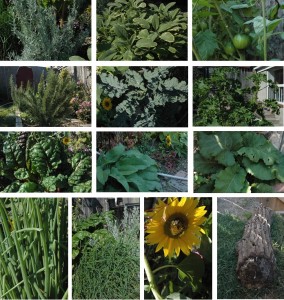
Oikos Network is working on an urban permaculture design and edible landscape for a Toronto home. From this site we hope to develop a template for other homes in urban cold temperate climates. The site will also act as an educational resource for future permaculture workshops and seminars, as well as an additional location for the Oikos Network Nursery to provide plants from and propagate.
We will be installing a medicinal and culinary herb garden, perennial vegetable garden, front yard fruit orchard and edible ornamental landscape, a low maintenance annual vegetable garden, as well as vertical gardens for maximum use of space.
Earth works and passive rainwater harvesting, along with heavy mulching and ground-cover planting, will largely minimize the need for watering and weeding, even in summer months.
Below are some garden photos from summer 2014

With the fall weather comes further preparation, experimentation, and research around food preservation and indoor gardening. We are currently using freezing, drying, seed saving & sprouting, and indoor growing methods. We will also be looking to create small outdoor poly-tunnels to extend the season of cold-hardy crops. A larger greenhouse may also be added to the south side of the house, just off the kitchen, in order to provide further winter growing space.
Freezing methods work best for watery or mucilaginous plants that will loose extensive nutrients through drying. These will include chives, walking onions, mallow, basil, swiss chard, sorrel, comfrey, and even some of the less watery plants like tarragon, parsley and mint.
The drying methods will mainly be used on herbs such as rosemary, sage, oregano, lavender, stinging nettle, and thyme, but also on more watery plants such as mints, parsley, tarragon, and comfrey.
Seed saving and sprouting is a great way to preserve, extract, and benefit from the stored nutrients in seeds. Some seeds that we will be experimenting with include chard, kale, spinach, nettle, burdock, garlic, onions, chives, and echinacea. However, other than seeds, many plants store nutrients in their roots, which can be stored and used to sprout young edible leaves. A good example of this is horseradish, as well as stinging nettle, and even burdock. However, bulbs from garlic, onions, chives, and shallots may also be used in this manner, and may be cut back several times.

